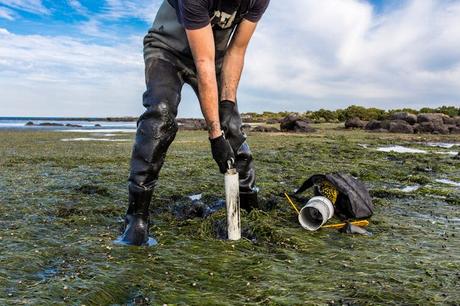Seagrass meadows are a hugely important sink for blue carbon - and so is the rest of the ocean floor Philip Schubert/Shutterstock " src="https://s.yimg.com/ny/api/res/1.2/VtPHHy0K8MbUDvCOTwobKw-/YXBwaWQ9aGlnaGxhbmRlcjt3PTk2MDtoPTU0MA-/https://media.zenfs.com/en/the_conversation_464/713d2b407ff8a2db5e66 050456e1be07″ data-src= "https://s.yimg.com/ny/api/res/1.2/VtPHHy0K8MbUDvCOTwobKw-/YXBwaWQ9aGlnaGxhbmRlcjt3PTk2MDtoPTU0MA-/https://media.zenfs.com/en/the_conversation_464/713d2b407ff8a2db5e660504 56e1be07″/>
"The science we need for the ocean we want" - this is the slogan for the UN Ocean Decade (2021-2030), which has just held its first conference in Barcelona, Spain. Marine scientists from around the world, including myself, gathered with world leaders to chart progress on this 10-year mission to improve ocean health and marine biodiversity. This also includes finding ways to better protect the seabed, about which we still know relatively little.
Some sediment areas on the seabed contain large amounts of carbon. Without better protection, disruption from bottom trawl fishing, for example, could release some of that stored carbon back into the atmosphere.
I participated in discussions in Barcelona that led to the launch of a new sustainable ocean planning initiative, which will be coordinated by Julian Barbière, Global Coordinator of the Ocean Decade. This aims to encourage commitment to sustainable management of 100% of the maritime area under a country's jurisdiction.
Now that this is in place, there is room to rethink the ocean's role in our broader climate system and recognize that all natural marine systems capture and store carbon in their soils and sediments.
I'm here on behalf of the Global Ocean Decade Program for blue carbon - that's all the carbon stored in the ocean. This project is one of 50 UN programs aimed at delivering transformative ocean science solutions for sustainable development, connecting people and our ocean. That's a big question.
My work focuses on the extraordinary ability of coastal ecosystems - such as mangroves, salt marshes and seagrass - to capture or store organic carbon at unusually high densities. Our blue carbon team of international research scientists from more than twenty countries is beginning to define emerging blue carbon ecosystems such as kelp forests and sub-tidal sediments as solutions to manage the climate and biodiversity crises.
The 360 million square kilometers of ocean and seafloor, from seagrass meadows on the coast to the sediment that slowly accumulates in the deepest trenches, is massively overlooked as a precious carbon sink. Oceans contain enormous amounts of carbon - the top meter of the ocean contains an estimated 2.3 trillion tonnes.
The story continues
The seabed is not a resource to be ruthlessly exploited, but a vulnerable store of global biodiversity and carbon that must be protected. These highly productive, but fragile ecosystems have been greatly affected by habitat loss and destructive practices such as the deforestation of mangroves for shrimp aquaculture in the relentless development of the world's coastal areas.
Blue carbon has enormous potential to provide ocean-based solutions to help mitigate climate change, and fortunately, at least on a global scale, these losses have declined in recent years.
Blue carbon's potential to reduce greenhouse gas emissions is relatively modest, but healthy, restored ecosystems have the potential to store an additional 2.96 million tons of carbon annually. Certain countries, such as Indonesia, offer enormous potential as blue carbon hotspots, where protecting and restoring nature offers opportunities both for the environment and for local communities.
Carbon credits, the means by which additional carbon can become a source of investment income in that community, are receiving a lot of interest. Off the coast of Kenya, the community-based Miko Pamojo project increases direct benefits to local people through mangrove restoration.

Blue carbon ecosystems can help countries meet their climate commitments and have attracted significant interest. However, if countries want these ecosystems to continue to provide a range of services, our governments must protect them and restore lost habitats where possible.
Most governments have been stubbornly slow to prioritize ocean-based solutions high on the agenda of global climate negotiations. At this conference I heard more people, including UNESCO's Director-General Audrey Azoulay, emphasize the need to protect and effectively manage our ocean resources.
Members of the Great Barrier Reef Traditional Owners spoke of 'land' from the perspective of a long and enduring human relationship with nature and its intimate connection with the ocean. There is growing recognition and respect for this indigenous knowledge and our need to integrate it into a sustainable ocean future.
A new look at the role of the ocean
It makes sense to start protecting these natural systems that already contain vulnerable carbon stocks - this is sensible risk management.
As countries continue to exploit the marine environment for fishing, fossil fuels and even precious metals now mined from the seabed in some places, it is time to reconsider the value of these vast natural reserves of ocean carbon.
Space science receives far more funding than our oceans, yet large parts of the global deep ocean remain largely unmapped. "Life underwater" is by far the least funded of the 17 UN Sustainable Development Goals. That must change through sustained and increased investment in ocean science and greater recognition of the value of our blue economy - defined by the UN as the sustainable use of the ocean's resources for economic growth, improved living standards and jobs.
Taking a step back to pause and preserve what already exists in the ocean can help the planet, and us, build resilience and create a healthier and more sustainable marine environment. The seafloor provides the foundation for an interconnected ocean ecosystem and acts as an important long-term global sink for carbon, involving the entire ocean and its exchanges with the atmosphere and the broader Earth system.
Although plans are finally moving in the right direction, enormous challenges lie ahead. To paraphrase Cynthia Barzuna, director of ocean action 2030 at the World Resources Institute, "there is no rich ocean without a healthy ocean." The biggest takeaway from the Barcelona conference is that a sustainable ocean future depends on a shared vision that applies to all of us, including marine life.
This article is republished from The Conversation under a Creative Commons license. Read the original article.


